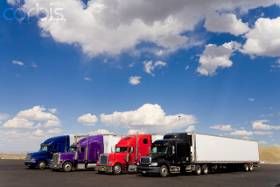Need Advice On Shifting Gears Smoothly And Easily...
Topic 1332 | Page 2
The advice I was given applies to a 10 speed or 9 speed only. Look at your speed gage and it will almost always tell you your gear. 25 (2+5=7) shift on the tens (10, 20, 30ect) low side shift between 1000 and 1200 rpms, highside shift between 1500 and 1700 rpms. Downshift at 1000 to 1200 and rev to 1400. Now every truck varies alittle but this is just a guide and really helps if you lose a gear.

Redgator, your right on the money on that shifting information.....it also helps, atleast in school and testing, where you have to double clutch , to know that the clutch never needs to go all the way to the floor. You can feel when it disengages..about 2 inches or so into the push down (if the clutch is adjusted correctly). So don't slap the floor with it...all it does is make your leg sore
Double Clutch:
To engage and then disengage the clutch twice for every gear change.
When double clutching you will push in the clutch, take the gearshift out of gear, release the clutch, press the clutch in again, shift the gearshift into the next gear, then release the clutch.
This is done on standard transmissions which do not have synchronizers in them, like those found in almost all Class A trucks.
Your right about that Star! I always had to hold the freeplay in (first inch of the clutch) Cause I clutched 2 deep. Now I found the rhythm. Also had an issue of reving too high on downshifting so I had to plant the ball of my foot in front the pedal and tap in. That helped bring it to 1400 and I got real good at the downshift! Well that and 1 weeks in the rockies

Thanks so much RedGator great advice i am writing that down to use in practice i think with your and star car's and Daniel b.'s advice i can markedly improve my gear shifting i'm not saying I can't shift heck i drove all over the northeast and we got everywhere pretty smoothly i just wanna be a master gear shifter i got the upshifting down it's the downshifting that's more troublesome the 2 plus 5 thing is great what about the next part? what do you mean by 10,20, 30? and yes I drove a 10 speed double clutch it was a freightliner cascadia model i believe by the way, what is the best gear for city driving like when you are on an expressway that is rather open but has frequent redlights? and what's the best gear for a congested city area ? I will give you some cash tips if i see you on the road for these answers okay IF i get on the road again
The advice I was given applies to a 10 speed or 9 speed only. Look at your speed gage and it will almost always tell you your gear. 25 (2+5=7) shift on the tens (10, 20, 30ect) low side shift between 1000 and 1200 rpms, highside shift between 1500 and 1700 rpms. Downshift at 1000 to 1200 and rev to 1400. Now every truck varies alittle but this is just a guide and really helps if you lose a gear.
Double Clutch:
To engage and then disengage the clutch twice for every gear change.
When double clutching you will push in the clutch, take the gearshift out of gear, release the clutch, press the clutch in again, shift the gearshift into the next gear, then release the clutch.
This is done on standard transmissions which do not have synchronizers in them, like those found in almost all Class A trucks.

<
The advice I was given applies to a 10 speed or 9 speed only. Look at your speed gage and it will almost always tell you your gear. 25 (2+5=7) shift on the tens (10, 20, 30ect) low side shift between 1000 and 1200 rpms, highside shift between 1500 and 1700 rpms. Downshift at 1000 to 1200 and rev to 1400. Now every truck varies alittle but this is just a guide and really helps if you lose a gear.
Please elaborate. Thnx.

Mark, I think she means like when you hit 25mph on road speed the RPMs will already be at the right spot to shift up to 7th, then at 35mph, shift to 8th, then at 45mph go to 9th gear and at 55mph, you should be in 10th thats the way i did it when I drove the truck in other words, with a ten speed, at every 10 mph increase, you shift up a gear

I have driven a manual transmission ever since I started learning to drive. Is there really much difference going to a big rig other than the shift pattern?
I have driven a manual transmission ever since I started learning to drive. Is there really much difference going to a big rig other than the shift pattern?
Yap, there's a huge difference. 4 wheelers have a synchronizer in their transmissions and big rigs don't.
What a synchronizer does is uses a system of clutches to match your engine crankshaft speed, your transmission shaft speed, and your road speed so that you can put it in any gear at any time. A big rig doesn't have that - the driver has to synchronize everything manually. So you can not just jam a big rig into 3rd gear at 50 mph the way you could a car. Everything has to be matched up perfectly or it won't go into gear.
For example, let's make up some numbers. Say at 35 mph a big rig's engine will turn 1,100 RPM in 8th gear. So if you're accelerating through 7th gear and you're ready to shift into 8th gear at 35 mph, the motor will have to be turning 1,100 RPM (or extremely close to that) in order for it to go into gear. If it isn't, you're just going to grind the gears and it won't let you shift.
You also have to double clutch which means you push the clutch pedal in to get it out of gear, release it when you're in neutral, press it in again, shift into the next gear, and release it again. So you clutch twice for each shift.
Double Clutch:
To engage and then disengage the clutch twice for every gear change.
When double clutching you will push in the clutch, take the gearshift out of gear, release the clutch, press the clutch in again, shift the gearshift into the next gear, then release the clutch.
This is done on standard transmissions which do not have synchronizers in them, like those found in almost all Class A trucks.
TWIC:
Transportation Worker Identification Credential
Truck drivers who regularly pick up from or deliver to the shipping ports will often be required to carry a TWIC card.
Your TWIC is a tamper-resistant biometric card which acts as both your identification in secure areas, as well as an indicator of you having passed the necessary security clearance. TWIC cards are valid for five years. The issuance of TWIC cards is overseen by the Transportation Security Administration and the Department of Homeland Security.

Wow! Okay. So when I went to beginner racing school when I was younger it doesn't mean the same thing. There you just keep accelerating while throwing the clutch and shifting. That is going to take a little practice. Maybe I should try it on my little rodeo so I can get used to pedaling the clutch like that.
OWI:
Operating While Intoxicated
New Reply:
New! Check out our help videos for a better understanding of our forum features

















Preview:
This topic has the following tags:
Advice For New Truck Drivers Tips For Shifting







 TT On Facebook
TT On Facebook
Now you newbies need to get to goin' on the High Road Training Program...That will teach you everything you will need for your cdl school. Also...you need to go thru CDL Practice Tests. So that when you go to take your permit tests and such, you will KNOW IT ALL....now get to work...Brett KNOWS when your workin' and when your not....hahahahaha...he's worse than Santa Claus....
CDL:
Commercial Driver's License (CDL)
A CDL is required to drive any of the following vehicles: